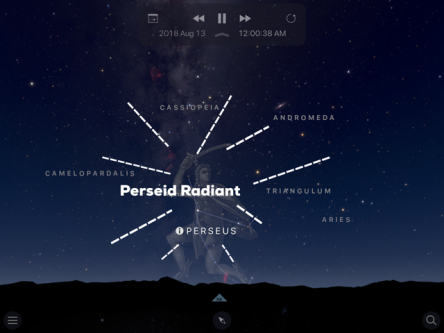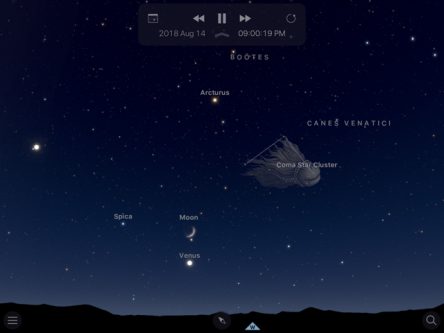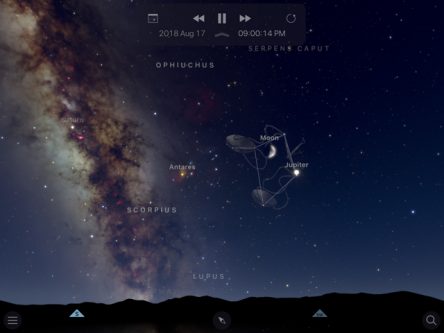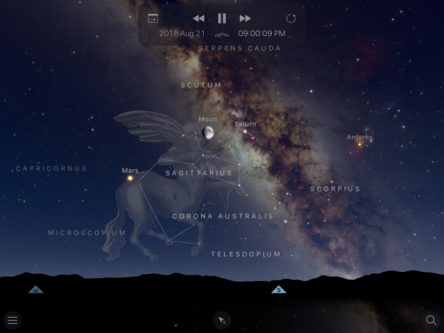

• Aug 1 – Maria Mitchell was born this day in 1818. Mitchell (1818-1889) was born in Nantucket, MA to a devout Quaker family. Fortunately, her particular community held equality in high regard and Maria’s passion for the stars was not hindered during her formative years. She became a first-class observer and discovered a comet when she was 30. Years later, she was awarded a medal for her discovery by King Frederick VI of Denmark. On the medal were inscribed these words: “Non Frustra Signorum Obitus Speculamur et Ortus”, which means, “Not in vain do we watch the setting and rising of the stars”. In 1865, Mitchell was the first person appointed as a faculty member to Vassar, as a professor of astronomy, making her the first professional woman astronomer in the United States. Due to her guidance and to her being so beloved by students, Mitchell recruited more students into the mathematics and astronomy programs than did Harvard in the years from 1865-1888.
• Aug 4 – Moon is at last quarter phase.
 • Aug 5 – Neil Armstrong, first human being to set foot upon the Moon, was born this day in 1930. Look for the biopic, First Man, opening in October and starring Ryan Gosling as Armstrong. The film is based upon the biography of the same name by James Hansen. In addition to having been an astronaut, Armstrong (1930-2012) had a career as an aviator, test pilot, Navy pilot, aeronautical engineer, and a university professor. Following his astronaut career, Armstrong taught aerospace engineering at the University of Cincinnati.
• Aug 5 – Neil Armstrong, first human being to set foot upon the Moon, was born this day in 1930. Look for the biopic, First Man, opening in October and starring Ryan Gosling as Armstrong. The film is based upon the biography of the same name by James Hansen. In addition to having been an astronaut, Armstrong (1930-2012) had a career as an aviator, test pilot, Navy pilot, aeronautical engineer, and a university professor. Following his astronaut career, Armstrong taught aerospace engineering at the University of Cincinnati.
• Aug 10 – The Moon is at perigee, the closest point in its orbit, at 1:07 P.M. CDT, at a distance of 222,500 miles away.
• Aug 11 – Moon is now at new phase.
 • Aug 12 –The Perseid Meteor Shower peaks tonight and into the early Monday morning hours, most meteors will likely be seen just before dawn of Monday morning. With the moon at new phase, the highest possible rate is about 50-80 meteors during the peak hours from a dark sky locale. However, the radiant, the point upon the sky from which the meteors all appear to originate, will only be 22 degrees above the NNE horizon at around midnight. This may mean seeing slightly fewer meteors than the maximum possible.
• Aug 12 –The Perseid Meteor Shower peaks tonight and into the early Monday morning hours, most meteors will likely be seen just before dawn of Monday morning. With the moon at new phase, the highest possible rate is about 50-80 meteors during the peak hours from a dark sky locale. However, the radiant, the point upon the sky from which the meteors all appear to originate, will only be 22 degrees above the NNE horizon at around midnight. This may mean seeing slightly fewer meteors than the maximum possible.
This is one of the best meteor showers for the year so don’t miss it. If you cannot make cannot make the peak nights, then be sure and check out the nights on either side of the peak, you may not see as many as you would during the peak, but you should still see some.
The most often asked question we get at this time of the year is: where can I go to escape the light pollution and see meteors?
The Ranch Northwoods Preserve, owned by The Nature Conservancy is a likely spot. Located at 8803 Ranch Blvd, Little Rock, this sight has reasonably dark skies for meteor shower watchers. Be sure to call the Conservancy just to make sure that they are okay with it (they have indicated before that they want the site to be used for this kind of thing) at 501-663-6699
The City Parks of Little Rock offers two potential sites:
The Natural Steps Sports Complex on Hwy 300, Roland Arkansas and Section 13 park, 10031 Garrison Rd. The sports complex has been abused by folks in the past and we are not sure about its current availability, but Section 13 has been sanctioned by the parks folks for use by meteor shower watchers this year. You can call the parks folks at 501-371-4770 just to be sure. Section 13 is listed as closed on the internet, but the parks people did grant permission to the Central Arkansas Astronomical Society to invite the public to use the spot for meteor shower observing.

August 14, 2018
• Aug 14 –Look to the west after sunset to see the Moon and Venus close together above the horizon.

August 17 2018
• Aug 17 – Look to the southwest after sunset to see the Moon and Jupiter close together in the sky.
• Aug 18 – The Moon is at first quarter.
 Free public star party at Pinnacle Mountain State Park’s
Free public star party at Pinnacle Mountain State Park’s
visitor center from 8pm-11pm with members of the Central Arkansas
Astronomical Society. Come out and look through their telescopes to
see some of the amazing sights currently overhead.

August 21, 2018
• Aug 21 – Look to the south this evening to see the Moon just east of Saturn. Brilliant Mars is the orange-red-looking “star” just to the southeast of the pair.
• Aug 27 – The Moon is at full phase.